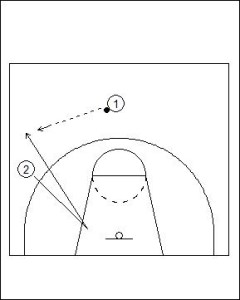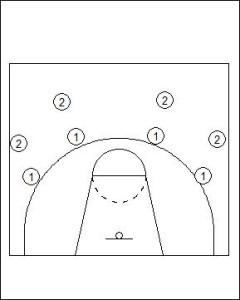Catching the Ball Out of Position
Catching the ball out of position is a very common problem experienced by coaches at all levels of basketball. Team offenses are designed to put players into the specific scoring positions that enable them and their teammates to achieve the highest percentage shot or desired outcome. When a player is catching the ball out of position, it nullifies or minimises these potential openings in an oppositions defence. Face this problem often enough and players will become frustrated and impatient, which will lead to poor decisions being engaged.
One of the common situations players find themselves catching the ball out of position is when moving to receive a pass on the three-point line. In the diagram (1) below a player has executed a good lead towards the basket, but unfortunately lifts well beyond the three-point line. This happen for a number of reasons. In some cases, the player does not seal their defensive match-up well enough on the v-cut and then has to lift further away from the intended catching position to receive the pass needed. A good seal is mandatory as the defensive player will try to assume a position between the ball handler and the receiver, which will be a shorter direct line then the receiver is moving along to their desired catching position. In some situations, if the defender is quicker than the offensive player this will even lead to a deflection or steal.

Another common reason for the situation above happening in regards to a player catching the ball out of position is the player is not aware of the spacing they need to work within. Players should have this position defined for them by the coach. Players should be provided with directions on where the optimum target area is for them to receive the pass after a v-cut. This will result in the player being effective for the offenses purposes.
Another commonly seen issue in catching the ball out of position is player receiving a pass in a position they cannot possibly be an offensive threat in. In most offensive system, players are asked to receive a pass in a position that allows them to shoot, drive or pass. When any of these three basic fundamental options are removed, the defence does not have to work so hard. In the diagram (2) below players should undertake a position on the three-point line where they can catch the ball and be an offensive threat (position number one), however the player if they catch in position number two will not fulfil this purpose because of their distance outside of a reasonable shooting range.

This situation is much more common than most people give it credit for. Many players at all levels of the sport struggle with catching the ball out of position. The reasons behind this situation can be varied when considered in the team context. Probably the most obvious reason is players have not be informed on where the correct area is. Sometimes explaining the need for a player to catch in this position so they can be within a reasonable shooting range is all that is needed and supported some drilling time during practice in five on five situations to reinforce the good habit.
Another common reason is players are no using the v-cut technique described earlier to free themselves from their defensive match-up. To effectively use the v-cut will require some practice and players must be given an opportunity to refine this movement and achieve the desired results. Perfecting this technique will result in a team’s offense being significantly more effective and smooth in execution.
Players sometimes also struggle with catching the ball out of position if they are new to the standard of competition. Players who are just trying to meet the needs of a new and challenging level of competition will pull up short in transition or in the general half-court offense so they are not pressured as heavily by the defensive intensity. In this situation players must be encouraged to face this challenge head on and learn how to overcome the speed and timing demands to ensure they can compete at the level required.
Catching the ball out of position increases the distance players must pass, which in turn means a ball is longer in the air increasing the chance of interception. This also the same situation for is a player decides to drive to the basket, the extra metre outside the three-point line will allow valuable seconds for the defence to rotate from help positions and limit the effectiveness of an attack. Think about a player needing three or four dribbles to make it into the keyway off an on-ball screen instead of only two and you will quickly realise the importance of not catching the ball out of position.







Leave a Reply